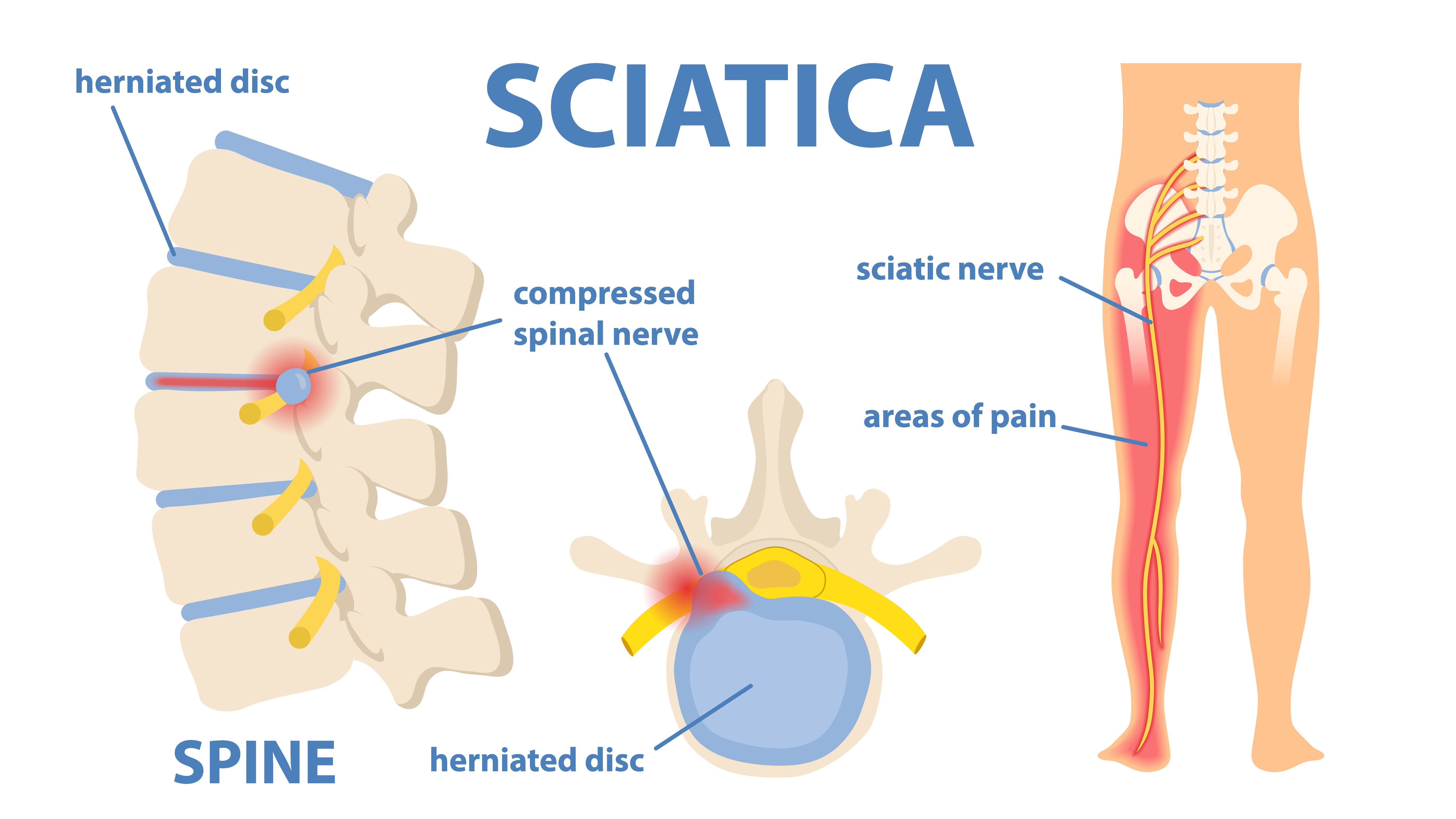Exercising with sciatica: Here’s how to do it, according to the experts
Worried about exercising with sciatica? Our experts explain how to do it safely and what exercises you should avoid

Exercising with sciatica might seem like an impossible task if you suffer from the condition, but it could alleviate your symptoms, experts believe. The sciatic nerve is the longest in your body, starting with nerve roots located in your lumbar spine (lower back) which then run through your hips, bum, and legs, down to your feet.
According to Spine Health, sciatica pain affects 10-40% of the population and refers to diagnosable symptoms like numbness, pain, and tingling sensations in your back and legs caused by a myriad of factors like aging or a herniated disc. For the majority of people, acute (mild) sciatica eases within four to six weeks without medical intervention, but for others, it can develop into a chronic lifelong condition.
Severe nerve pain can be debilitating and, sadly, it takes some exercises and styles of training off the table completely. The good news? Learning how to exercise with sciatica (rather than avoiding it altogether) could help you live a healthier, pain-free life.
We spoke with experts to delve deeper into what sciatica is, why it occurs, and how exercising with sciatica to relieve sciatic nerve pain really does work, as well as what to avoid altogether.
What is sciatica?
“Sciatica refers to pain that runs through the sciatic nerve, from your lower back down to your foot,” Miss Vivian Elwell, consultant neurosurgeon at London Bridge Hospital, tells Live Science. “It’s caused by compression, irritation, or damage to the sciatic nerve which is usually caused by a herniated disc in the spine or a bone spur (bony projections that grow in joints) on the vertebrae.”
Miss Vivian Elwell is a Consultant Neurosurgeon with a sub-speciality in Complex Spinal Surgery. She began her undergraduate studies at Columbia College, Columbia University (NYC, USA) with a degree in Biological Sciences. She completed her medical degree at the University of Cambridge and Imperial College School of Medicine. she was awarded the British Association of Spinal Surgeons President Travelling Fellowship and the International Group for Advancement in Spinal Science Fellowship (IGASS).
The sciatic nerve is responsible for motor function (helping your arms and legs move) and sensory function (enabling you to feel sensation in your legs and feet), so any damage to this nerve can cause some serious problems.

Elwell explains that symptoms include shooting pains, numbness, and weakness in your leg which worsen when standing or walking. “Risk factors include age-related changes, obesity, prolonged sitting, and diabetes mellitus,” she says. “It can happen at any point in life, but men are three times more likely to suffer from this condition, and it normally occurs between the ages of 40 and 50.”
Get the world’s most fascinating discoveries delivered straight to your inbox.
Adam Foster, director at The Fibro Guy Ltd (a rehabilitation service for chronic pain and hypermobility syndromes), agrees that there is a myriad of ways for the irritation to set in, including nerve pinching and genetic abnormalities. “Luckily though, sciatica is rarely mechanical in nature, and issues like nerve impingement are rarer to come by because of the abundance of room at our nerve roots.”
However, because some movements can aggravate the compressed nerve, many people believe that exercise should be avoided entirely – which isn’t the case at all. Gentle exercise can help alleviate pain and speed up recovery, but it’s crucial to differentiate between the types of exercises that can help and ones that can hinder.
So, what exercises can you still enjoy safely?
Best exercises for sciatica
“Bed rest has been a popular treatment for sciatica for the better part of the last few decades,” Foster tells us. “But the best thing we can do is to keep relatively active.”
In terms of published evidence, most meta-analyses and reviews show that there are no significant benefits to bed rest over staying active when it comes to sciatica pain (and vice versa). However, as mentioned in a review posted in Spine, “because there is no considerable difference between advice to stay active and advice for bed rest, and there are potentially harmful effects of prolonged bed rest, it is reasonable to advise people with acute low back pain and sciatica to stay active.”
Jodie Breach, physiotherapy lead for Nuffield Health, agrees. “Most people will find gentle movement helps settle their pain,” she says. “Likely, you’ll still get some pain while exercising, but this doesn’t necessarily mean it’s causing damage. The key is finding the right level of exercise.”

Jodie Breach is the National Physiotherapy Lead at Nuffield Health, U.K. She gained her Bachelor of Science in Physiotherapy from the University of Birmingham in 2002, and a Master's in Clinical Research from the University of Manchester in 2021. Breach has a special interest in foot and ankle rehab, as well as vestibular rehab.
Foster recommends combining a mix of stretching and mobility work. However, stretching has more of an effect on your nervous system than the actual tissue, so he advises moving slowly and carefully. “Gentle dynamic movement can be incredibly beneficial for your range of motion,” he advises.

Elwell advises working closely with a physiotherapist who can direct which exercises are beneficial for you. “Slow and gentle stretches are advised,” she agrees. “Yoga, Pilates, swimming, walking, and stationary indoor cycling are all great options, and it’s important to remain as active as possible with your day-to-day activities.”
A good guiding principle is that pain should be tolerable and settle relatively quickly post-exercise, so if that isn’t the case, intensity should be reduced.
Exercises to avoid if you have sciatica
“There are several helpful exercises for anyone struggling with sciatica, but there are also several which can aggravate pain,” explains Elwell. “Any high-impact exercise should be kept to a minimum, including contact sports, running, football, and tennis. These sports put sudden and intense strain or rotational forces through your back and can potentially worsen your underlying symptoms.”
Elwell recommends going to the gym, but jumping, bending forward, twisting, and lifting both your legs together could aggravate pressure on the sciatic nerve. She recommends avoiding exercises like:
- Burpees
- Double leg raises
- Toe touches
- Weighted squats
- Bentover rows, and
- Outdoor cycling
Instead, stretches that gently target the lower back and glutes – performed on some of the best yoga mats for support – could help release muscle tension. Think knee-to-chest stretches (laying or standing), reclined pigeon pose, and yoga for back pain.
Other ways to manage sciatica
Both Elwell and Foster recommend applying heat or ice pads to relieve pain, improve blood flow, and relax muscles, but if you’re struggling with numbness this should be used with caution. And seeking a spinal assessment or visiting your doctor is also advisory if your pain worsens.
“Heat won’t do much for the nerve of the piriformis muscle (one of your deeper gluteal muscles) that can irritate sciatica,” warns Foster. “But it will provide some relief to calm your nervous system. Likewise, vibration therapy reduces muscle soreness and can help treat muscle inflammation.”
Most importantly though, remember that prevention is key and ensure you look after your back and general health by remaining active, managing your weight, and investing in a good quality mattress. Learning how to get a stronger core and how to improve your flexibility could also help you to protect your lower back during exercise.

Sam Hopes is a level III fitness trainer, level II reiki practitioner, and resident fitness writer at Future PLC. Having trained to work with both the mind and body, Sam is a big advocate of using mindfulness techniques in sport and aims to bring mental wellbeing to the forefront of fitness. She’s also passionate about the fundamentals of training and how we can build more sustainable training methods. You’ll find her writing about the importance of habit-building, nutrition, sleep, recovery, and workouts.


